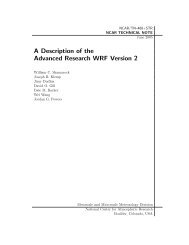Create successful ePaper yourself
Turn your PDF publications into a flip-book with our unique Google optimized e-Paper software.
MODEL<br />
b. Vertical velocity damping (w_damping): For operational robustness, vertical motion<br />
can be damped to prevent the model from becoming unstable with locally large<br />
vertical velocities. This only affects strong updraft cores, so has very little impact on<br />
results otherwise.<br />
c. Divergence Damping (sm_div): Controls horizontally propagating sound waves.<br />
d. External Mode Damping (em_div): Controls upper-surface (external) waves.<br />
e. Time Off-centering (epssm): Controls vertically propagating sound waves.<br />
Advection Options<br />
a. Horizontal advection orders for momentum (h_mom_adv_order) and scalar<br />
(h_sca_adv_order) can be 2 nd to 6 th , with 5 th order being the recommended one.<br />
b. Vertical advection orders for momentum (v_mom_adv_order) and scalar<br />
(v_sca_adv_order) can be 2 nd and 6th, with 3 rd order being the recommended one.<br />
c. Monotonic transport (option 2, new in Version 3.1) and positive-definite advection<br />
option (option 1) can be applied to moisture (moist_adv_opt), scalar (scalar_adv_opt),<br />
chemistry variables (chem_adv_opt) and tke (tke_adv_opt). Option 1 replaces<br />
pd_moist = .true. etc. in previous versions.<br />
Some notes about using monotonic and positive-definite advection options:<br />
The positive-definite and monotonic options are available for moisture, scalars,<br />
chemical scalers and TKE in the <strong>ARW</strong> solver. Both the monotonic and positivedefinite<br />
transport options conserve scalar mass locally and globally and are consistent<br />
with the <strong>ARW</strong> mass conservation equation. We recommend using the positivedefinite<br />
option for moisture variables on all real-data simulations. The monotonic<br />
option may be beneficial in chemistry applications and for moisture and scalars in<br />
some instances.<br />
When using these options there are certain aspects of the <strong>ARW</strong> integration scheme<br />
that should be considered in the simulation configuration.<br />
(1) The integration sequence in <strong>ARW</strong> changes when the positive-definite or<br />
monotonic options are used. When the options are not activated, the timestep<br />
tendencies from the physics (excluding microphysics) are used to update the scalar<br />
mixing ratio at the same time as the transport (advection), and the microphysics is<br />
computed and moisture is updated based on the transport+physics update. When the<br />
monotonic or positive definite options are activated, the scalar mixing ratio is first<br />
updated with the physics tendency, and the new updated values are used as the<br />
starting values for the transport scheme. The microphysics update occurs after the<br />
transport update using these latest values as its starting point. It is important to<br />
remember that for any scalars, the local and global conservation properties, positive<br />
definiteness and monotonicity depend upon each update possessing these properties.<br />
<strong>WRF</strong>-<strong>ARW</strong> V3: User’s <strong>Guide</strong> 5-29

















